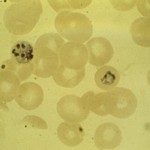Lien vers Pubmed [PMID] – 38395885
Lien DOI – 10.1186/s12936-024-04887-1
Malar J 2024 Feb; 23(1): 55
Plasmodium vivax Duffy binding protein (PvDBP) is a merozoite surface protein located in the micronemes of P. vivax. The invasion of human reticulocytes by P. vivax merozoites depends on the parasite DBP binding domain engaging Duffy Antigen Receptor for Chemokine (DARC) on these red blood cells (RBCs). PvDBPII shows high genetic diversity which is a major challenge to its use in the development of a vaccine against vivax malaria.A cross-sectional study was conducted from February 2021 to September 2022 in five study sites across Ethiopia. A total of 58 blood samples confirmed positive for P. vivax by polymerase chain reaction (PCR) were included in the study to determine PvDBPII genetic diversity. PvDBPII were amplified using primers designed from reference sequence of P. vivax Sal I strain. Assembling of sequences was done using Geneious Prime version 2023.2.1. Alignment and phylogenetic tree constructions using MEGA version 10.1.1. Nucleotide diversity and haplotype diversity were analysed using DnaSP version 6.12.03, and haplotype network was generated with PopART version 1.7.The mean age of the participants was 25 years, 5 (8.6%) participants were Duffy negatives. From the 58 PvDBPII sequences, seven haplotypes based on nucleotide differences at 8 positions were identified. Nucleotide diversity and haplotype diversity were 0.00267 ± 0.00023 and 0.731 ± 0.036, respectively. Among the five study sites, the highest numbers of haplotypes were identified in Arbaminch with six different haplotypes while only two haplotypes were identified in Gambella. The phylogenetic tree based on PvDBPII revealed that parasites of different study sites shared similar genetic clusters with few exceptions. Globally, a total of 39 haplotypes were identified from 223 PvDBPII sequences representing different geographical isolates obtained from NCBI archive. The nucleotide and haplotype diversity were 0.00373 and 0.845 ± 0.015, respectively. The haplotype prevalence ranged from 0.45% to 27.3%. Two haplotypes were shared among isolates from all geographical areas of the globe.PvDBPII of the Ethiopian P. vivax isolates showed low nucleotide but high haplotype diversity, this pattern of genetic variability suggests that the population may have undergone a recent expansion. Among the Ethiopian P. vivax isolates, almost half of the sequences were identical to the Sal-I reference sequence. However, there were unique haplotypes observed in the Ethiopian isolates, which does not share with isolates from other geographical areas. There were two haplotypes that were common among populations across the globe. Categorizing population haplotype frequency can help to determine common haplotypes for designing an effective blood-stage vaccine which will have a significant role for the control and elimination of P. vivax.

